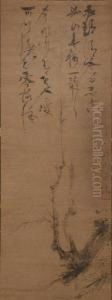Ikkyu Sojun Paintings
Ikkyu Sojun was a unique figure in the history of Japanese Zen Buddhism, known for his eccentricity, profound poetry, and unorthodox approach to Zen practice. Born in 1394 in Kyoto, Japan, Ikkyu was the illegitimate son of Emperor Go-Komatsu, which marked his early life with complexities. Despite his noble birth, he was sent to a Rinzai Zen monastery at a young age, where he began his Buddhist training. His early experiences in the monastery were marked by rigorous meditation and studies, yet Ikkyu grew to be critical of the formalities and perceived corruption within the Zen establishment of his time.
Throughout his life, Ikkyu challenged the conventional norms of Zen Buddhism and Japanese society. He was known for his disdain for mere formalistic Zen practices and emphasized direct experience and insight. Ikkyu's approach to Zen was deeply personal and often manifested through his poetry, calligraphy, and interactions with people from all walks of life, including those marginalized by society. His works express themes of impermanence, the importance of mindfulness, and the pursuit of enlightenment through unconventional means.
Ikkyu's contribution to Japanese culture extends beyond his religious practice. He is celebrated for his calligraphy and poems, which are considered exemplary of the Japanese aesthetic of beauty tinged with melancholy. His life and teachings had a lasting impact on the arts, particularly the tea ceremony, noh theater, and Japanese poetry. Despite his critical stance towards the religious establishment, Ikkyu was posthumously awarded the title of Zen master and is remembered as a pivotal figure in Zen Buddhism.
Ikkyu Sojun died in 1481, leaving behind a legacy that continues to influence both Zen Buddhism and Japanese culture. His life is a testament to the power of authenticity, creativity, and the pursuit of spiritual enlightenment outside the confines of traditional structures. Ikkyu remains a beloved and respected figure in Japan, revered not only for his spiritual insight but also for his contributions to the arts and culture.
